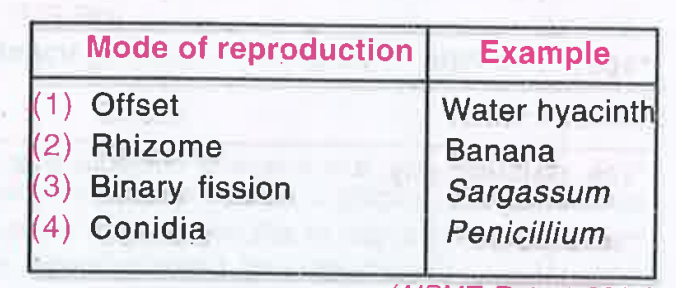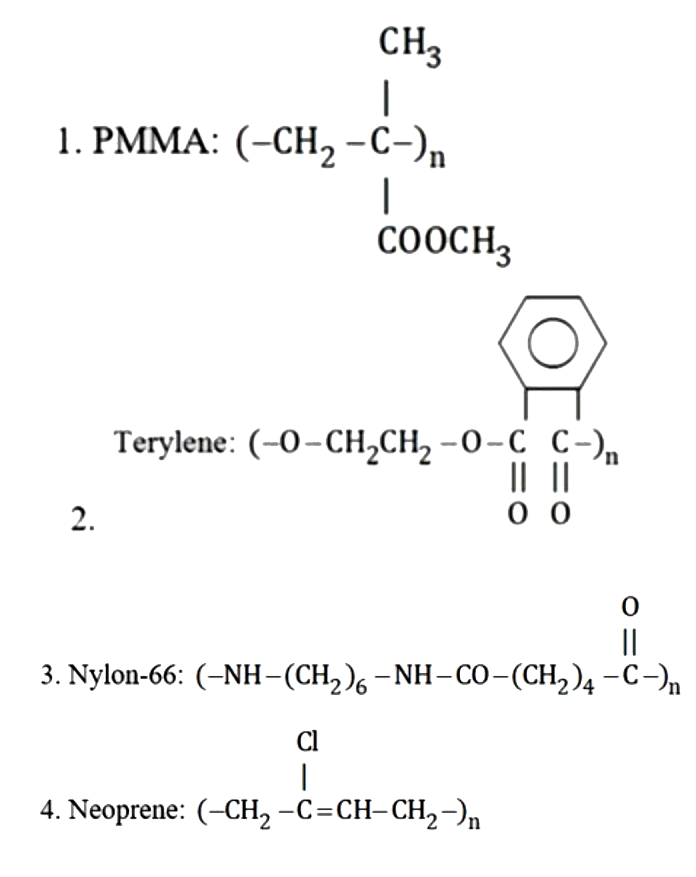Which of the following polymers is not correctly matched ?
Formation of dacron-Step growth polmerisation
Formation of polytetrafluoroethene- step growth polymerisation
Formation of polythene-Chain growth polymerisation in presence of benzoyl peroxide
Formation of polyacylonitrile - Chain growth polymerisation in presence of peroxide
The correct Answer is:B
To solve the question "Which of the following polymers is not correctly matched?", we need to analyze the given options based on the types of polymerization processes involved in their formation.
1. Identify Types of Polymers:
- There are two main types of polymers:
- Addition Polymers: Formed through chain growth polymerization.
- Condensation Polymers: Formed through step growth polymerization.
2. List Examples of Each Type:
- Addition Polymers: Examples include polytetrafluoroethene (PTFE), polyethylene, and polyacrylonitrile.
- Condensation Polymers: Examples include Dacron (a type of polyester) and Nylon.
3. Evaluate Each Option:
- Option A: Formation of Dacron by step growth polymerization.
- Dacron is indeed a condensation polymer, so this match is correct.
- Option B: Formation of polytetrafluoroethene by step growth polymerization.
- Polytetrafluoroethene is an addition polymer, so it should be formed by chain growth polymerization. This match is incorrect.
- Option C: Formation of polyethylene by chain growth polymerization in the presence of benzoyl peroxide.
- Polyethylene is an addition polymer, and its formation through chain growth polymerization is correct.
- Option D: Formation of polyacrylonitrile by chain growth polymerization in the presence of peroxide.
- Polyacrylonitrile is also an addition polymer, and its formation through chain growth polymerization is correct.
4. Conclusion:
- The incorrectly matched polymer is Option B: Formation of polytetrafluoroethene by step growth polymerization.
Final Answer:
The polymer that is not correctly matched is Option B: Formation of polytetrafluoroethene by step growth polymerization.
---
- There are two main types of polymers:
- Addition Polymers: Formed through chain growth polymerization.
- Condensation Polymers: Formed through step growth polymerization.
- Addition Polymers: Examples include polytetrafluoroethene (PTFE), polyethylene, and polyacrylonitrile.
- Condensation Polymers: Examples include Dacron (a type of polyester) and Nylon.
- Option A: Formation of Dacron by step growth polymerization.
- Dacron is indeed a condensation polymer, so this match is correct.
- Option B: Formation of polytetrafluoroethene by step growth polymerization.
- Polytetrafluoroethene is an addition polymer, so it should be formed by chain growth polymerization. This match is incorrect.
- Option C: Formation of polyethylene by chain growth polymerization in the presence of benzoyl peroxide.
- Polyethylene is an addition polymer, and its formation through chain growth polymerization is correct.
- Option D: Formation of polyacrylonitrile by chain growth polymerization in the presence of peroxide.
- Polyacrylonitrile is also an addition polymer, and its formation through chain growth polymerization is correct.
- The incorrectly matched polymer is Option B: Formation of polytetrafluoroethene by step growth polymerization.
The polymer that is not correctly matched is Option B: Formation of polytetrafluoroethene by step growth polymerization.
Topper's Solved these Questions
- BOOK - NCERT FINGERTPS ENGLISHCHAPTER - POLYMERS EXERCISE - EXEMPLAR PROBLEMS9videos
POLYMERS
- BOOK - NCERT FINGERTPS ENGLISHCHAPTER - POLYMERS EXERCISE - ASSERTION AND REASON15videos
POLYMERS
- BOOK - NCERT FINGERTPS ENGLISHCHAPTER - HALOALKANES AND HALOARENESEXERCISE - NCERT Exemplar27videos
HALOALKANES AND HALOARENES
- BOOK - NCERT FINGERTPS ENGLISHCHAPTER - PRACTICE PAPER -1EXERCISE - Practice Paper 150videos
PRACTICE PAPER -1
Similar Questions
Knowledge Check
- Question 1 - Select One
Which of the following examples is not correctly matched ?
A(A)Two most abundant elements -Fe, Al.B(B)Two metals which occur in native state -Au, Pt.C(C)Two metals which can occur in combined and native state both -Zn, FeD(D)None of these - Question 2 - Select One
Which of the following pairs is not correctly matched.
APower of Parliament : Creating a new StateBPower of State Legislature : Altering the name of a StateCEquality before the law : Both Indian and non- Indian citizensDEquality of opportunity : Indian citizen - Question 3 - Select One
Which of the following azeotropes is not correctly matched ?
AHNO3 (68%) +H2O(32%) ,Maximum boiling azeotrope , boiling point =393.5 KBH2O(43%) + HI(57%) : Minimum boiling azeotrope , boiling point =290 KCC2H5OH (95.5%) + H2O (4.5%) : Minimum boiling azeotrope , boiling point = 351.15 KDChloroform (93.2%) +C2H5OH(6.8%) : Minimum boiling azeotrope, boiling point =332.3 K
Which of the following pairs is not correctly matched ?
 View Solution
View SolutionWhich of the following pairs is not correctly matched ?
View SolutionWhich of the following polymers are correctly matched ?

2. Nylon - 66 : ⎛⎜ ⎜⎝−NH−(CH2)6−NH−CO−(CH2)4−O∣∣C−⎞⎟ ⎟⎠n
4. N e oprene : ⎛⎜ ⎜⎝−CH2−Cl∣C=CH−CH2−⎞⎟ ⎟⎠nView SolutionWhich of the following is/are not correctly matched?
View SolutionWhich of the following examples is correctly matched ?
View Solution

